- Operation Plumbbob
-
Operation Plumbbob 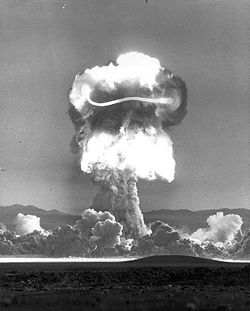
Plumbbob PriscillaInformation Country United States Test site Nevada Test Site Period April - October 1957 Number of tests 30 Test type Atmospheric Device type Fission/Thermonuclear Max. yield 74 kt Navigation Previous test Project 57 Next test Project 58 Operation Plumbbob was a series of nuclear tests conducted between May 28 and October 7, 1957, at the Nevada Test Site, following Operation Redwing, and preceding Operation Hardtack I. It was the biggest, longest, and most controversial test series in the continental United States.
Contents
Background
The operation was the sixth test series and consisted of 29 explosions, of which only two did not produce any nuclear yield. Twenty-one laboratories and government agencies were involved. While most Operation Plumbbob tests contributed to the development of warheads for intercontinental and intermediate range missiles, they also tested air defense and anti-submarine warheads with smaller yields. They included forty-three military effects tests on civil and military structures, radiation and bio-medical studies, and aircraft structural tests. Operation Plumbbob had the tallest tower tests to date in the U.S. nuclear testing program as well as high-altitude balloon tests. One nuclear test involved the largest troop maneuver ever associated with U.S. nuclear testing.
Almost 1,200 pigs were subjected to bio-medical experiments and blast-effects studies during Operation Plumbbob. On shot Priscilla (37 KT), 719 pigs were used in various experiments on Frenchman Flat. Some pigs were placed in elevated cages and provided with suits made of different materials, to test which materials provided best protection from the thermal pulse. As shown and reported in the PBS documentary Dark Circle, the pigs survived, but with third-degree burns to 80% of their bodies.[1] Other pigs were placed in pens behind large sheets of glass at measured distances from the hypocenter to test the effects of flying debris on living targets.
Approximately 18,000 members of the U.S. Air Force, Army, Navy and Marines participated in exercises Desert Rock VII and VIII during Operation Plumbbob. The military was interested in knowing how the average foot-soldier would stand up, physically and psychologically, to the rigors of the tactical nuclear battlefield.
Studies were conducted of radiation contamination and fallout from a simulated accidental detonation of a weapon; and projects concerning earth motion, blast loading and neutron output were carried out.
Nuclear weapons safety experiments were conducted to study the possibility of a nuclear weapon detonation during an accident. On July 26, 1957, a safety experiment, "Pascal-A," was detonated in an unstemmed hole at NTS, becoming the first underground shaft nuclear test. The knowledge gained here would provide data to prevent nuclear yields in case of accidental detonations - for example, a plane crash.
The Rainier shot, conducted September 19, 1957, was the first fully contained underground nuclear test, meaning that no fission products were vented into the atmosphere. This test of 1.7 KT could be detected around the world by seismologists using ordinary seismic instruments. The Rainier test became the prototype for larger and more powerful underground tests.
Radiological effects
Plumbbob released 58,300 kilocuries (2.16 EBq) of radioiodine (I-131) into the atmosphere. This produced total civilian radiation exposures amounting to 120 million person-rads of thyroid tissue exposure (about 32% of all exposure due to continental nuclear tests).
Statistically speaking, this level of exposure would be expected to eventually cause between 11,000 and 212,000 excess cases of thyroid cancer, leading to between 1,000 and 20,000 deaths.[2]
In addition to civilian exposure, troop exercises conducted near the ground near shot "Smoky" exposed over three thousand servicemen to relatively high levels of radiation. A survey of these servicemen in 1980 found significantly elevated rates of leukemia: ten cases, instead of the baseline expected four.[citation needed]
The first nuclear-propelled manmade object in space?
During the Pascal-B nuclear test, a heavy (900 kg) steel plate cap (a piece of armor plate) was blasted off the top of a test shaft at an unknown speed. Before the test, experimental designer Dr. Brownlee had performed a highly approximate calculation that suggested that the nuclear explosion, combined with the specific design of the shaft, would accelerate the plate to six times escape velocity.[3] The plate was never found, but Dr. Brownlee believes that the plate never left the atmosphere (it may even have been vaporized by compression heating of the atmosphere due to its high speed). The calculated velocity was sufficiently interesting that the crew trained a high-speed camera on the plate, which unfortunately only appeared in one frame, but this nevertheless gave a very high lower bound for the speed. After the event, Dr. Robert R. Brownlee described the best estimate of the cover's speed from the photographic evidence as "going like a bat!"[4][5] The use of a subterranean shaft and nuclear device to propel an object to escape velocity has since been termed a "thunder well".
This incident was reputedly used as part of the technical justification for the Orion project for possible use of nuclear blasts for outer-space propulsion.
Objects can only be propelled to very high velocities by a nuclear explosion if they are located close to the burst point. Once a nuclear fireball has grown to a radius that is similar in size to the radius of a quantity of high explosive of similar yield, its energy density is about the same and very high velocities would not be produced. This radius for a 300 ton explosion is 3.5 meters.
The steel plate at the top of the shaft was over 150 m from the nuclear device, much too far for it to be propelled to extreme velocity directly by the explosion. The feature of Pascal-B that made this possible was the placement of the collimator close to the device. The mass of the collimator cylinder was at least 2 tonnes (if solid) and would have been vaporized by the explosion, turning it into a mass of superheated gas that expanded and accelerated up the shaft, turning it into a giant gun. It was the hypersonic expanding column of vaporized concrete striking the cover plate that propelled it off the shaft at high velocity.
To illustrate the physics, and estimate how fast it might have been going, consider that if the collimator absorbed a substantial part of the explosion energy (say a third of it, or 100 tons) it would have been heated to temperatures far higher than any conventional explosive (by a factor of 50 with the previous assumption).
The maximum velocity achieved by an expanding gas is determined by the equation:
u = 2c/(gamma - 1)
where u is the final velocity, c is the speed of sound in the gas, and gamma is the specific heat ratio of the gas. If we further assume that the thermodynamic properties of vaporized concrete are similar to the hot combustion gases of high explosives, then the speed of sound in the vaporized collimator would be about 7 km/sec (the square root of 50 times the value of c for an explosive combustion gases, which is 1 km/sec). For molecular gases gamma is usually in the range of 1.1 to 1.5, for explosives it is 1.25. Thus we get:
u = 2*7 km/sec / (1.25 - 1) = 56 km/sec
This is about five times Earth's 11.2 km/sec escape velocity, quite close to the figure of six times arrived at by Dr. Brownlee in his detailed computations. But the assumption that it might have escaped from Earth is implausible (Dr. Brownlee's discretion in making a priority claim is well advised). Leaving aside whether such an extremely hypersonic unaerodynamic object could even survive passage through the lower atmosphere, it appears impossible for it to retain much of its initial velocity while passing through the atmosphere. A ground launched hypersonic projectile has the same problem with maintaining its velocity that an incoming meteor has. According to the American Meteor Society Fireball and Meteor FAQ meteors weighing less than 8 tonnes retain none of their cosmic velocity when passing through the atmosphere, they simply end up as a falling rock. Only objects weighing many times this mass retain a significant fraction of their velocity.
The fact that the projectile was not found of course is no proof of a successful space launch. The cylinder and cover plate of Pascal-A was also not found, even though no hypersonic projectile was involved. Even speeds typical of ordinary artillery shells can send an object many kilometers, beyond the area of any reasonable search effort.
List of test blasts
Test Name Date Yield Note Image Boltzmann 28 May 1957 12 kt Tower shot 
Franklin 2 June 1957 140 tons Fizzled 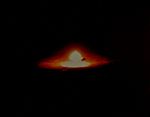
Lassen 5 June 1957 0.5 kt Balloon shot 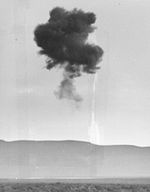
Wilson 18 June 1957 10 kt Balloon shot 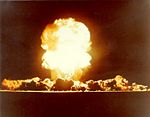
Priscilla 24 June 1957 37 kt Balloon shot 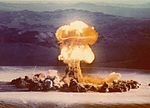
Coulomb-A 1 July 1957 zero yield Safety experiment Hood 5 July 1957 74 kt Balloon shot, largest atmospheric test in the continental United States 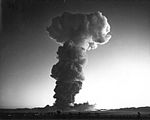
Diablo 15 July 1957 17 kt Tower shot 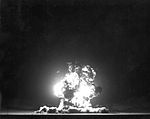
John 19 July 1957 2 kt Live fire of AIR-2 Genie air-to-air rocket 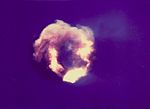
Kepler 24 July 1957 10 kt Tower shot 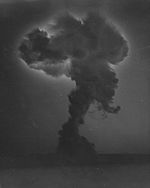
Owens 25 July 1957 9.7 kt Balloon shot 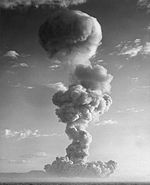
Pascal-A 26 July 1957 55 tons Shaft safety experiment. Yield described as slight. Expected yield was 1–2 pounds.[6] Stokes 7 August 1957 19 kt Balloon 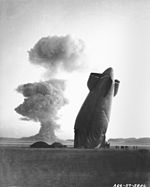
Saturn 10 August 1957 Zero yield Shaft safety experiment Shasta 18 August 1957 17 kt Tower shot 
Doppler 23 August 1957 11 kt Balloon shot 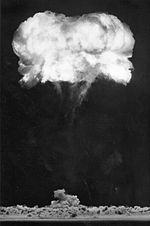
Pascal-B 27 August 1957 300 tons Shaft safety experiment. Yield often described as slight. Expected yield was 1–2 pounds.[5] Franklin Prime 30 August 1957 4.7 kt Balloon 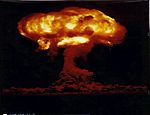
Smoky 31 August 1957 44 kt Tower shot 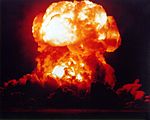
Galileo 2 September 1957 11 kt Tower shot 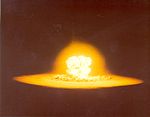
Wheeler 6 September 1957 197 tons Balloon shot 
Coulomb-B 6 September 1957 300 tons Surface safety experiment Laplace 8 September 1957 1 kt Balloon shot 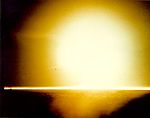
Fizeau 14 September 1957 11 kt Tower shot 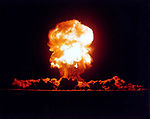
Newton 16 September 1957 12 kt Balloon shot 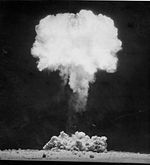
Rainier 19 September 1957 1.7 kt Tunnel shot. First US underground nuclear test. 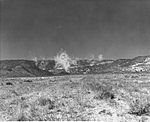
Whitney 23 September 1957 19 kt Tower shot 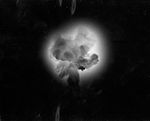
Charleston 28 September 1957 12 kt Balloon shot 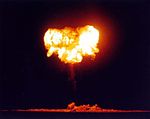
Morgan 7 October 1957 8 kt Balloon Shot 
References
- "United States Nuclear Tests, July 1945 through September 1992 (DOE/NV-209)" (pdf). U.S. Department of Energy Nevada Operations Office. 2000. http://www.nv.doe.gov/library/publications/historical/DOENV_209_REV15.pdf. Original source for test information.
- Plumbbob page on the Nuclear Weapons Archive (also refers to manhole cover issue mentioned above).
- "Estimated Exposures and Thyroid Doses Received by the American People from Iodine-131 in Fallout Following Nevada Atmospheric Nuclear Bomb Tests". National Cancer Institute. 1997. http://www.cancer.gov/i131/fallout/index.html.
External links
Notes
- ^ Dark Circle, DVD release date March 27, 2007, Directors: Judy Irving, Chris Beaver, Ruth Landy. ISBN 0-7670-9304-6. http://www.pbs.org/pov/darkcircle/
- ^ Institute of Medicine (U.S.). Committee on Thyroid Screening Related to I-131 Exposure, National Research Council (U.S.). Committee on Exposure of the American People to I-131 from the Nevada Atomic Bomb Tests, ed (1999). Exposure of the American people to Iodine-131 from Nevada nuclear-bomb tests: review of the National Cancer Institute report and public health implications. National Academies Press. pp. 113–114. ISBN 9780309061759. http://books.google.com/books?id=vGtce6RjjM0C&pg=PA114&dq=%22operation+plumbbob%22+OR+nevada+atmospheric+%22thyroid+cancer%22&cd=2#v=onepage&q=%22operation%20plumbbob%22%20OR%20nevada%20atmospheric%20%22thyroid%20cancer%22&f=false.
- ^ Brownlee, Robert R. (June 2002). "Learning to Contain Underground Nuclear Explosions". http://nuclearweaponarchive.org/Usa/Tests/Brownlee.html. Retrieved 2006-07-31.
- ^ Learning to Contain Underground Nuclear Explosions By Dr. Robert R. Brownlee - June 2002
- ^ a b Pascal B test at the Nuclear Weapon Archive
- ^ Pascal A test at the Nuclear Weapon Archive
Coordinates: 37°08′10″N 116°04′07″W / 37.13611°N 116.06861°W
Categories:- Nevada Test Site
- American nuclear explosive tests
- Radiation health effects
- 1957 in the United States
Wikimedia Foundation. 2010.
